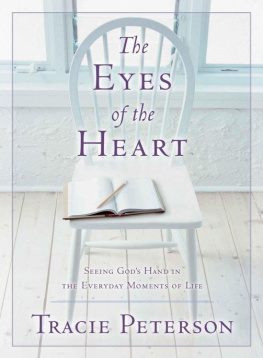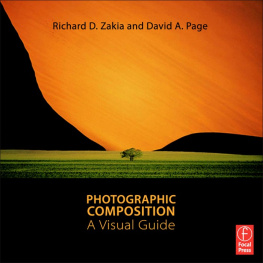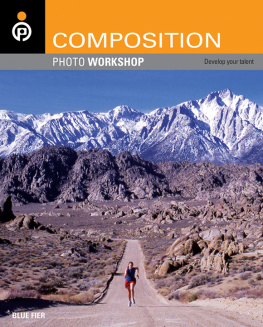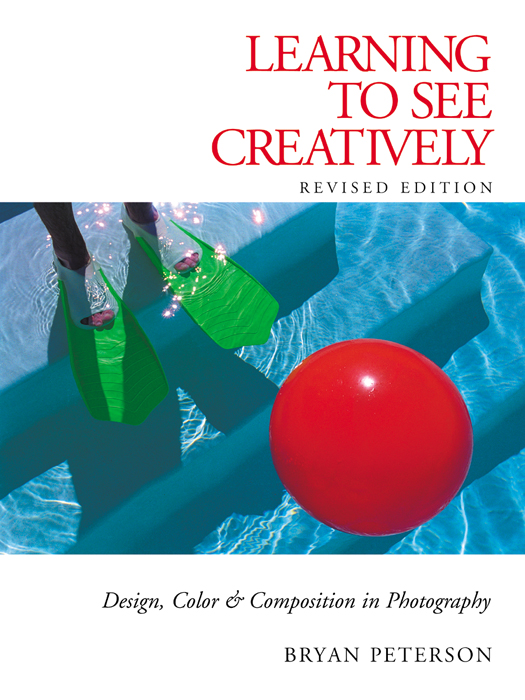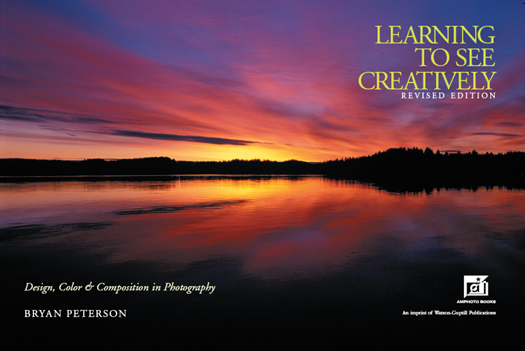First published in 2003 by Amphoto Books
an imprint of Watson-Guptill Publications
a division of the Crown Publishing Group,
Random House, Inc., New York
www.amphotobooks.com
www.crownpublishing.com
www.watsonguptill.com
Senior Editor: Victoria Craven
Project Editor: Alisa Palazzo
Designer: Bob Fillie, Graphiti Design, Inc.
Production Manager: Hector Campbell
Cover design by Bob Fillie, Graphic Design
Front cover photo by Bryan Peterson
Copyright 2003 Bryan Peterson
Library of Congress Cataloging-in-Publication Data
Peterson, Bryan F.
Learning to see creatively : design, color & composition in photography /
Bryan Peterson. rev. ed.
p. cm.
Includes index.
eISBN: 978-0-8174-0023-1
1. Composition (Photography) 2. Photography, Artistic. 3. Picture perception. I. Title.
TR179.P47 2003
771dc21
2003010501
All rights reserved.
v3.1
Acknowledgments
Id like to thank the thousands of photographers who purchased the previous edition of this book, as well as my former editor, Robin Simmen; senior editor, Victoria Craven; current editor, Alisa Palazzo; and designer, Bob Fillie.
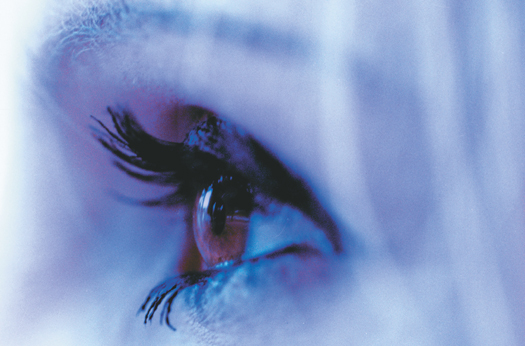
To my beautiful wife, Kathy, with whom I will be in love forever
CONTENTS
INTRODUCTION
D o you see what I see? Do you hear what I hear? Its the Christmas season, and in the background my radio is tuned to a station playing that Christmas song. The timing couldnt be better as I sit down to write the introduction to this completely revised edition of my book Learning to See Creatively (Amphoto, 1988). Do you see what I see? Maybe, maybe not. Even if youre standing right next to me and I see something that I want to share with you, you still may not see it until all that remains is a glimpse. My daughters both spotted a hot-air balloon up in the sky the other day. It wasnt until it was almost out of sight that I finally spotted it, but by then it was merely a dot in the vast sky. It was frustrating for all of us, to be sure.
What does this story have to do with picture taking? It is analogous to picture taking and creative vision. All of us who are blessed with sight can see, but why is it that someone right next to us can see something of interest, yet we somehow miss it? If youve ever participated in a photography workshop in the field or gone out shooting with a friend from the local camera club, you know what I mean: Standing at the head of a trail you are bewildered, lost, and confused, while within minutes someone else is setting up a camera and tripod three feet away, zeroing in on a graphic composition of autumn-colored leaves. You watch in amazement and ask the most often heard question at workshops and field trip outings: Why didnt I see that!?
The answer may be a combination of things. Perhaps you were preoccupied with thoughts about your job, or hadnt dressed appropriately for the location and were shivering like crazy. Not being able to see is probably the greatest hurdle every photographer has to overcome. However, even once you begin to seereally seeyou are faced with the next hurdle: composing all that great stuff in a balanced and harmonious fashion.
I know of no real rules that one must follow to learn how to see, but I do know of many, many principles and techniques that are designed to help you see. The aim of this book is to not only teach you how to recognize a picture-taking opportunity but also to challenge that conservative way of seeing that often leads to dull, ordinary photographs. Throughout this book, many of the examples are pairs of images that show you before and after, as well as good and better. These pictures are certainly not intended to be the right way, but simply my interpretation of a particular scene at that particular moment in time.

Fifteen years have passed since Learning to See Creatively was first published. So much has changed, thanks in large measure to the many, many innovations of the photography industry. I recall joking at a seminar I taught back in 1990 that I was waiting for the industry to come out with a 20400mm F2.8 zoom lens with ED glass and internal focusing. Although there is still no such lens on the market today, I can truthfully say that one day we will see just such a lens. Today, you can leave the house and head for the mountains or beach with no more than a camera and two lenses, and be ready for any subject that crosses your pathwhether it be a close-up of a butterfly, the distant brown bear, or that big ball of orange flames setting in the western sky. Due to optical advances in the zoom lens arena, zoom lenses now rival and compete head to head with the once-favored sharper single-focal-length lenses.

However, the challenge still remains: To advance your personal vision, you must really practice and also exploit the vision of your lenses, no matter their zoom ratio or amazing sharpness. This all-new edition of Learning to See Creatively explores the subject of personal vision in great depth, with accompanying exercises throughout that promise to unleash the visionary in youregardless of technology. Whether youre using film or, like many photographers, not bothering with film anymore and instead shooting everything digitally, as the old saying goes, The more things change, the more things stay the same. Although I am the first to embrace change, using it is another matter. Even if I did employ the latest and greatest camera, lens, or photo-imaging software program, it would have very little impact on the one vital ingredient that separates a ho-hum image from an OMG (Oh my God!): creativity.
Creativity is perhaps best described as a combination of inventiveness, imagination, inspiration, and perception. The photography industry has yet to introduce a camera that searches out unique and interesting subject matter. There still isnt a camera that will alert you to the two other compelling compositions that lie in wait next to the one youre currently shooting. There still isnt a camera that instinctively recognizes the decisive moment. And, there still isnt a camera that will systematically arrange your composition in a balanced and harmonious fashion before you expose it digitally or on film. These are challenges that continue to be part of the wonderful world of image making, challenges for which the sole responsibility of success or failure rests squarely on your shoulders.
When I wrote the previous edition of Learning to See Creatively, I had one goal in mind: to dispel the myth that the art of image making was for the chosen few. Based on the overwhelming and positive responses Ive heard at my many workshops and on-line courses, as well as contained in the many letters and e-mails Ive received, I feel I reached that goal. This all-new, completely rewritten and reillustrated edition promises to continue to dispel the myth. In addition, Ive added a section on color in the Elements of Design chapter, and I discuss in depth not only colors value as a design element, but also its impact on our mind and emotions. And again through the use of comparison images, youll see the value of focusing your vision on line, shape, form, texture, and pattern, and how these elements are a strong force in creating truly compelling photographic compositions.







